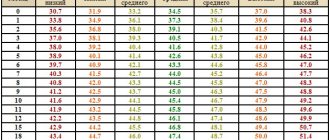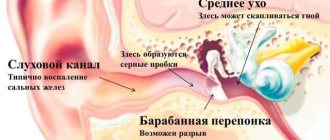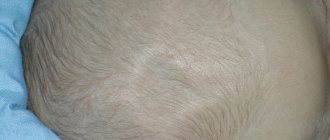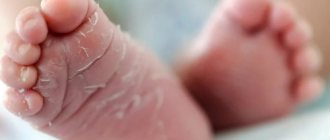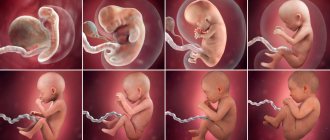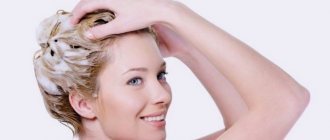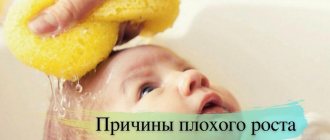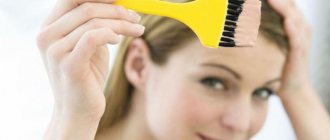Determination of acceptable boundaries of a phenomenon
During the development of the embryo, all kinds of processes are activated, and the formation of hair is natural.
A child is born with hair on his head, sometimes there is a lot of it, and in some cases it is a small fluff.
But sometimes a newborn is born with small hairs on the shoulders, back and ears.
Don't worry, in most cases this is a natural phenomenon and the hairs will disappear on their own after some time.
By the age of 3 months, the baby has only a small fluff on his body. If the bristles begin to harden and do not disappear by 4 months, then you should consult a doctor; it is likely that the child has genetic abnormalities. In this case, the pediatrician will refer you for a special examination.
When to worry
There are cases when experts consider abundant hair growth in a newborn as an anomaly. Let's consider the following options:
- Stigmas. These are the so-called minor anomalies, among which there is a significant increase in the amount of hair in the baby. Hypertrichosis can be expressed by fused eyebrows or a triangular headland of hair on the forehead.
- “Island” hair covering. It is also considered a deviation from the norm, especially if the abundant presence of hair is not characteristic of the child’s race, nationality, or heredity;
- Hair on a child's ears remains for a long time, and also appears on other parts of the body, except the palms and feet. This is characteristic of Wolfman syndrome, most often combined with abnormalities of the outer parts of the ears. This is a fairly rare phenomenon, found mainly in India.
If you doubt whether your child has remnants of lanugo on his body or has any abnormality, consult a doctor for advice.
Reasons for appearance
Lanugo occurs while the fetus is still in the womb - at the 12th week of development.
As the fetus grows larger, the coarse hairs, which gradually die off, are replaced by unnoticeable fluff.
It is worth noting that lanugo in the fetus is a protective reaction of a small organism; it does not pose any danger.
In the womb, the baby’s body secretes a specific waxy substance that helps it pass unhindered through the birth canal during childbirth. Hairs are necessary to ensure that as much lubricant as possible lingers on the skin. In addition, the substance that accumulates on the bristles prevents amniotic fluid from affecting the baby’s skin.
As you can see, lanugo in a newborn is a common physiological phenomenon. A small bristle normalizes heat exchange in a child and can protect against minor scratches and injuries.
Some mothers wonder why the hair does not die off after the birth of a child? There are several reasons for this:
- the most common reason encountered in medical practice is prematurity. If a child is born prematurely, then his body is not yet fully formed and the hairs simply did not have time to disappear in time;
- stigmas, or abnormal hair growth. This disease is detected only after a complete examination of the newborn, prescribed by a doctor;
- heredity that cannot be discounted. For example, people with Caucasian roots have increased body hair. And if the baby has similar roots, then it is likely that lanugo will persist for a long time after birth;
- a pathology that is worth thinking about - hairs remain on the child’s body after several months have passed since birth. In this case, complex treatment is prescribed.
Causes of lanugo
Body hair in newborns is completely normal. Just like adult hair, such as eyebrows or eyelashes, lanugo is needed to protect the child. They retain a necessary substance in his body - lubricant, which plays an important role during intrauterine development and the birth process.
Click to get 5 video lessons about the secrets of raising and developing a child up to one year old!
While the baby is in the stomach, this lubricant protects it from the effects of amniotic fluid, and during childbirth it facilitates the movement of the baby through the birth canal. They also serve as a heat keeper and protect the newborn’s delicate skin from minor injuries. Why don't they fall out immediately after birth? There may be several reasons:
- Prematurity of the newborn. This is the most common reason; in premature babies, such hair simply does not have time to fall out in a timely manner, since he is born earlier than planned;
- Abnormal hair development, or stigma. Only a doctor can identify the main cause of stigmas after examining the newborn;
- Heredity. If the baby has Caucasian or Eastern roots among his relatives, then the likelihood of preserving lanugo even after his birth increases;
- Pathological development. This is worth talking about if the hair does not fall out within several months after birth. In this case, complex treatment may be prescribed.
Important! Lanugo does not cause any discomfort to the newborn and does not cause restless sleep or poor appetite!
But why a baby may sleep poorly, read the article: Why does a newborn sleep poorly?>>>
The primary source of these phenomena needs to be looked for elsewhere, but this should not be connected in any way with embryonic hairs. Although the hair can be quite coarse and not at all like fluff, which is why some mothers conclude that it simply disturbs the baby. It also happens that a baby develops bristles, read this article: Bristles in a newborn>>>
What is lanugo?
Many mothers are very worried when they see a lot of hair on a child’s body, especially if it is on the baby’s ears.
And often even the doctors’ arguments cannot reassure them, since the fear for the health of their beloved child is much stronger than the ability to understand medical terminology. Let's look at the main points.
Lanugo is hairs on the baby's body that did not fall out while the baby was in the womb. Just wait a little, and they will dry out or fall out - in 3 months, or even earlier.
These hairs cannot cause illness or problems with sleep and nutrition. Even if the baby has elevated hormonal levels, lanugo is safe.
You should not experiment and use various folk recipes for removing ear hairs in the first days of life. Wait a little, just bathe the baby in water with the addition of decoctions of medicinal plants.
Methods for getting rid of ear hair
Often grandmothers advise to quickly get rid of such a phenomenon as lanugo, with the help of bread crumb, which is used to roll out the hairs.
Even if you take this method into account, it is problematic to do this on a baby’s ears.
In addition, rolling out, pulling out and other physical impacts can lead to injury to the baby’s delicate skin. It is likely that a foreign infection will get into the wounds; this can lead to serious consequences.
It is strictly forbidden to cut or shave the hairs on the ears, as this can make them much tougher and begin to grow rapidly, which will only cause harm to the newborn.
Often, when using creams and oils, hairs can roll into small lumps, which will cause a lot of trouble for the baby: they interfere with sleep, causing inconvenience, and sometimes cause pain. In this case, the child will need additional skin care. The main thing you should pay attention to in this case is high-quality hygiene.
- The main thing is bathing with a sponge or soft mitten, which allows you to painlessly and quickly rid the baby of unwanted hairs. While bathing, let your child lie in the bath for a little while so that the pellets soften and are removed during washing.
- Use decoctions of medicinal herbs, but this must be done with special caution, as the child may develop an allergy. For example, if you plan to use a washcloth, brew chamomile; it soothes irritated skin, and the series, in turn, disinfects and relieves itching.
- Mobility greatly influences lanugo to go away faster. Intense and active games dry out the hairs, so constantly turn the newborn from side to side. Lay on your back. Remove diapers so your baby can wag his arms and move his legs. With the ears, of course, this is problematic, since they only come into contact with the cap.
- If the hairs on your ears really bother you, you can buy a special mitten made of soft microfiber and periodically rub them. But you just need to act with caution so as not to cause harm.
- Frequently wearing caps and caps, especially after swimming, helps wipe out the hairs that are located on the ears.
What you are absolutely not allowed to do to remove unwanted hairs on your baby’s body:
- roll out with bread crumb or specially prepared dough. Your baby's body may become irritated, red, and severely itchy. The child will feel discomfort and this will make him restless;
- use tweezers to remove. Firstly, it is very painful, especially on the delicate skin of the ears, and secondly, it can cause infection;
- use depilatory products. You can simply burn the delicate skin with chemical compounds, and treatment after that will require serious and long-term treatment;
- You should not use medication without a doctor's prescription.
It must be remembered that it is strictly forbidden to injure the baby’s skin; it is his protective barrier against many diseases and infections. Be patient, and you will see for yourself that by 4 months only barely noticeable fluff will remain on the ears.
If 6 months have passed and the hairs on the ears have not fallen out, but, on the contrary, have begun to cause discomfort to the child, then urgently contact a doctor who will send the child for examination to identify the causes of this phenomenon.
Source: momjournal.ru
What kind of hair does a newborn have?
A newborn may be born completely hairless, covered only with grease, or with barely noticeable light fluff, or, on the contrary, may have long and thick dark hair. The last option surprises parents if this is completely uncharacteristic of their genotype, for example, when they are both blond.
This factor is not decisive, because the hair color of newborns depends on the amount of melanin - a special pigment inherent at the genetic level and regulated with the participation of the endocrine system, which forms the general hormonal background.
And due to the fact that the baby’s hair grows in the womb, at the time of birth it can have an impressive length. But by 2-3 months they will still fall out, after which new hair will begin to appear in the vacant space, which will receive a shade characteristic of the child. The final color inherited from the parents will only appear in the fifth year of the baby’s life.
This is why some babies are born with a full head of hair
From DA
25.08.2017 10:10 16161
What will your baby be like?
Do you remember how your baby was born - with a bald head like a billiard ball or covered with hair? – SureJoy is interested. Some children are born bald, others, on the contrary, with hair on their heads. Do you know why?
Before you give birth, your brain already “knows” what the baby will be like.
The type of hair and its color depend on our genes and the ethnic group to which we belong. Your baby will have straight blonde hair because yours is the same! This is typical for most children, but there are exceptions.
Don't be surprised if your baby is fair and you are not.
What determines the amount of hair in a newborn?
In this sense, the determining factors include:
- heredity;
- nationality;
- race.
For example, people originally from the south or east have the thickest hair compared to the rest of the country's inhabitants, which is ultimately passed on to their children, who often also have hair on their chests or limbs.
Sometimes experts associate a significantly increased amount of hair in a newborn with minor developmental anomalies and say that the child was born “with stigmas” (fused eyebrows, a hairy cape on the forehead, etc.).
Deviations include the so-called “island” covering, not characteristic of race or nationality, in which the newborn’s hair takes up space not only on the head. Having noticed them, the doctor should inform the parents about this, and also find out whether this feature of the baby is the only one and whether it is associated with more serious disorders.
Mom's questions
- Does hair color change in newborns? Children born with blond hair may darken as they age. The reason for this phenomenon is not fully understood. What is known is that the color of curls depends on the level of eumelanin, the amount of which changes over time. You can finally say whether your baby will be blond or brunette only by the age of two.
Hair color changes can last up to two years
- When does a newborn’s hair change, and why is it gone by 9-10 months? Children's trichologists advise not to worry about the presence or absence of hair at this age. The issue of a healthy scalp is much more important. It should be uniform in color, without redness, soft and free of flaking. Healthy skin will sooner or later have beautiful hair.
Causes of hair loss in a newborn
It happens that a child born with thick hair loses half of it within the first month, and the remaining hair noticeably thins and continues to fall off.
Why does a newborn's hair fall out? Because this phenomenon is closely related to the hormonal changes in his body, which has finally separated from the mother’s. And because color, like the amount of hair, depends not only on genes. Changed hormonal levels become the main reason for their loss. Basically, we are talking about partial hair loss (intermediate stage), when the hair is renewed gradually, but sometimes they can all be eliminated at the same time. In this case, the newborn goes into the stage of complete baldness: old hair falls out so rapidly that new hair does not have time to grow, but even this can be avoided.
Bald patches that appear on your baby are quite normal. Regardless of the length and thickness of the hair, most often it occurs in places where the head is in constant contact with a cap or pillow and is a consequence of friction. To prevent the appearance of such bald spots, the baby must be turned more often from back to stomach or from one side to the other. The process of hair renewal will be completely completed by about 2 years, and after six months the fluff that appeared at birth should disappear.
Most of the hair is on the head, but often parents pay attention to the fact that there is hair on the back of the newborn, it can also be on the shoulders. There the hairs are the thinnest, light or darker, and fall out quite quickly (in a few days). The hair on the head of newborns is thickest and coarsest. Over time, they strengthen and, as a rule, lighten. The most stable color is formed by 5 years. In addition, hair on the ears of a newborn may be noticeable, usually thin (fluff) and short-lived.
For a baby, the process of hair loss is painless and unnoticeable, but if (according to the parents) it is accompanied by a number of other processes, for example, increased sweating, darkening of the skin, loud crying, etc., then you need to consult a doctor to rule out the presence of rickets, which is common among newborns diseases.
Hair loss problems - warning signs
The hair of babies, just like the curls of adults, signals various changes in the body.
Alopecia areata
This type is characterized by tufted hair loss, which leaves smooth patches of skin on the scalp. The process is so rapid that in just a few days the baby’s hair can fall out completely.
Main reasons:
- a malfunction of the immune system, in which the hair follicles are destroyed by the body's antibodies;
- mental trauma;
- imbalance of the thyroid gland;
- stress.
If left untreated, alopecia areata progresses to total.
Pocket hair loss in newborns - the reasons may be hidden even in the fright that the baby experienced once
Hair follicle injury
This type of baldness is associated exclusively with children's hair and is unfamiliar to adults. The main reason lies in the frantic desire of parents to shave their baby's head.
Note! You can't shave children! With just one awkward movement, you can damage your hair follicles beyond repair.
Young parents ask when to cut a newborn's hair. But there is no need for this, except for following the ancient beliefs of ancient times
The second myth often gives rise to the question of when to cut the hair of a newborn. Thanks to this misconception, it is very easy to recognize toddlers on the playground who have recently celebrated their first anniversary.
Cutting the hair of a newborn and even a one-year-old baby does not have any physiological basis. Hair thickness is programmed genetically and does not depend on haircuts or lack thereof.
By the age of one year, children's hair becomes denser and grows faster. This fact is often mistakenly made as a consequence of the haircut.
When can you cut a newborn's hair? Then, when they bother him, growing to eye level
Interesting to know! Shaving of children has been done since ancient times. However, such actions were a necessity and were dictated by overcrowding and poor hygiene. Babies were shaved to facilitate hair care and reduce lice.
Telogen effluvium
Occurs against the background of cessation of hair growth and its transition to a “coma” state. The reasons for this condition lie in injuries, overdose of drugs or vitamins, and surgery. Telogen effluvium is a temporary phenomenon and goes away after the causes are eliminated.
Note! Hair loss, which is accompanied by increased sweating and changes in the shape of the head, may indicate the development of rickets.
Newborn hair care
From the first days of a child's life, his hair will require careful care. They need to be washed as often as necessary, mainly during standard water procedures. As a means of washing hair, it is necessary to use special shampoo or soap for newborns, but immediately limit their use to once a week so as not to interfere with the healing process of the fontanel and not to provoke the formation of crusts. The optimal water temperature is 37 degrees. After washing, you should not dry your hair by rubbing it vigorously; just gently pat it dry with a towel.
To prevent hair loss in newborns, it is advisable to rinse your hair with a warm decoction of chamomile or string, which prevent the development of inflammatory processes. It is recommended to carefully examine the child’s scalp every day, and if there is flaking, remove scaly remains with a sparse comb. If it does not peel off, then for the purpose of prevention it must be moisturized with sterilized oil for children, rubbing it into the roots of the hair.
Should a newborn's hair be cut?
There is an opinion that a newborn's hair will grow thicker if it is shaved, and it is advisable to do this before a year, while it is still quite soft. However, such a procedure will have virtually no effect on either hair growth or thickness, since the peculiarities of their structure are genetically determined. Although there will indeed be more of them, but for the reason that the primary fluff was removed mechanically even before it was replaced naturally.
Parents are usually interested in when a newborn's hair is cut? Age does not matter here, the main thing is to cut them off as needed, for example, when they start to get into the eyes or during the summer season, if the baby is not comfortable with them.
Even if newborns have very sparse hair on their heads, they should still be brushed regularly: stimulating the nerve endings at the roots will promote their growth. In this case, the comb should not be hard, otherwise the fontanel may be damaged.
Knowing the characteristics of hair growth in a newborn and observing the requirements for caring for it, you can create the prerequisites for the formation of thick and strong hair, and in the future avoid problems with hair loss.
Author of the article: Tsarinnik Nonna Vladimirovna
Source: www.rastut-goda.ru
Causes
The development of lanugo hairs on the baby's body begins in the womb, around the twelfth week. Gradually, as the fetus develops, some hairs die off and are replaced by others, thinner and almost invisible. In fact, lanugos do not pose any danger, quite the contrary. They are called upon to protect the child. These hairs retain the substance that the baby’s body secretes while in the womb, thanks to which the small organism develops fully.
The reasons for the appearance of excessive hair include the following:
- If a newborn has hair on his body and quite a lot of it, then most likely it’s all a matter of heredity and the predominance of the hormone responsible for hair growth - testosterone.
- Anomalies in the development of hair, which are called stigmas. Based on a full examination of the child, only a doctor can identify the cause of their occurrence.
- Premature birth. Since the baby is premature, the lanugo has not yet completely fallen out.
- Pathology. We can talk about it if the lanugo did not disappear a few months after the baby was born. In this case, mandatory visits to doctors and courses of treatment that will be prescribed are indicated.
Methods of disposal
Doctors recommend taking some measures that will be aimed at removing hair if the newborn has it. They are quite simple, so following them will not be difficult.
- Be sure to bathe your baby regularly;
- When bathing, it is important to use a soft sponge or washcloth, with which you can wash off the hairs with gentle massage movements;
- Constantly turn the baby over and change the position of his body.
If, after using creams and baby powders aimed at avoiding skin irritations, the hairs roll into small tufts, they can cause additional discomfort and sometimes even pain. In this case, it is necessary to bathe the baby daily, perhaps even twice a day, if there is really a need for it.
Features of structure and growth
A baby's hair is not much different from an adult's; the only difference is the pH of the scalp and the thickness of the hairs. The first hair that covers the baby's head and body appears in the womb, called lanugo or vellus.
They are very short and soft, contain virtually no pigment, and only in the eighth month of pregnancy are they partially replaced by pigmented ones.
By the time of birth, lanugo disappears in most babies, and only a small number of children who are born prematurely surprise their parents with a large number of hairs.
Often, older people recommend removing lanugo with their own hands, but doctors are categorically against such interference in the natural process of hair rolling.
Already at this stage, the first myth “Rolling out hair in newborns” arises. Compassionate grandmothers suggest soaking the crumb of bread and using this ball to roll up the newborn’s body hair.
These actions do not make any sense and do not help improve the baby’s well-being or sleep. This myth is related to the popular belief that hair appears on a baby’s body because the mother, while pregnant, kicked cats.
In the first years of life, vellus hairs are replaced by intermediate ones, this is especially noticeable in the first 3-4 months. At this time, up to 300 hairs can fall out daily, but this does not indicate rickets or other abnormalities in the child’s health.
By the age of six months, hairs again cover the baby’s head, but the most active growth of curls is observed at the age of 2-3 years.
